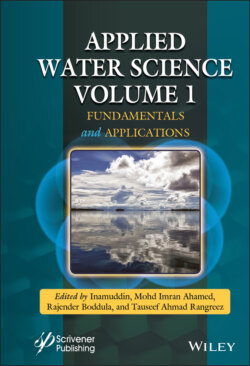Читать книгу Applied Water Science - Группа авторов - Страница 2
Table of Contents
Оглавление1 Cover
2 Title Page
3 Copyright
4 Preface: Applied Water Science I-Fundamentals and Applications
5 1 Sorbent-Based Microextraction Techniques for the Analysis of Phthalic Acid Esters in Water Samples 1.1 Introduction 1.2 Solid-Phase Microextraction 1.3 Stir Bar Sorptive Extraction 1.4 Solid-Phase Extraction 1.5 Others Minor Sorbent-Based Microextraction Techniques 1.6 Conclusions Acknowledgements References
6 2 Occurrence, Human Health Risks, and Removal of Pharmaceuticals in Aqueous Systems: Current Knowledge and Future Perspectives 2.1 Introduction 2.2 Occurrence and Behavior of Pharmaceutics in Aquatic Systems 2.3 Human Health Risks and Their Mitigation 2.4 Knowledge Gaps and Future Research Directions 2.5 Summary, Conclusions, and Outlook Author Contributions References
7 3 Oil-Water Separations 3.1 Introduction 3.2 Sources and Composition 3.3 Common Oil-Water Separation Techniques 3.4 Oil-Water Separation Technologies 3.5 Separation of Oil/Water Utilizing Meshes 3.6 Separation of Oil-Water Mixture Using Bioinspired Surfaces 3.7 Conclusion Acknowledgements References
8 4 Microplastics Pollution 4.1 Introduction and General Considerations 4.2 Key Scientific Issues Concerning Water and Microplastics Pollution 4.3 Marine Microplastics: From the Anthropogenic Litter to the Plastisphere 4.4 Social and Human Perspectives: From Sustainable Development to Civil Science 4.5 Conclusions and Future Projections References
9 5 Chloramines Formation, Toxicity, and Monitoring Methods in Aqueous Environments 5.1 Introduction 5.2 Inorganic Chloramines Formation and Toxicity 5.3 Analytical Methods for Inorganic Chloramines 5.4 Organic Chloramines Formation and Toxicity 5.5 Analytical Methods for Organic Chloramines 5.6 Conclusions References
10 6 Clay-Based Adsorbents for the Analysis of Dye Pollutants 6.1 Introduction 6.2 Membrane Filtration 6.3 Chemical Treatment 6.4 Photo-Catalytic Oxidation 6.5 Conclusions Acknowledgments References
11 7 Biochar-Supported Materials for Wastewater Treatment 7.1 Introduction 7.2 Generalities of Biochar: Structure, Production, and Properties 7.3 Biochar-Supported Materials 7.4 Conclusion References
12 8 Biological Swine Wastewater Treatment 8.1 Introduction 8.2 Swine Wastewater Characteristics 8.3 Microorganisms of Biological Swine Wastewater Treatment 8.4 Classification of Biological Swine Wastewater Treatment 8.5 Biological Processes For Swine Wastewater Treatment 8.6 Challenges and Future Prospects in Swine Wastewater Treatment References
13 9 Determination of Heavy Metal Ions From Water 9.1 Introduction 9.2 Detection of Heavy Metal Ions 9.3 Conclusions References
14 10 The Production and Role of Hydrogen-Rich Water in Medical Applications 10.1 Introduction 10.2 Functional Water 10.3 Reduced Water 10.4 Production of Hydrogen-Rich Water 10.5 Mechanism Hydrogen Molecules During Reactive Oxygen Species Scavenging 10.6 Hydrogen-Rich Water Effects on the Human Body 10.7 Other Effects of Hydrogenated Water 10.8 Applications of Hydrogen-Rich Water 10.9 Safety of Using Hydrogen-Rich Water 10.10 Concluding Remarks References
15 11 Hydrosulphide Treatment 11.1 Introduction 11.2 Conclusions References
16 12 Radionuclides: Availability, Effect, and Removal Techniques 12.1 Introduction 12.2 Existing Techniques and Materials Involved in Removal of Radionuclide 12.3 Summary of Various Nanomaterial and Efficiency of Water Treating Technology 12.4 Management of Radioactive Waste 12.5 Conclusion References
17 13 Applications of Membrane Contactors for Water Treatment 13.1 Introduction 13.2 Characteristics of Membrane Contactors 13.3 Membrane Module Configurations 13.4 Mathematical Aspects of Membrane Contactors 13.5 Advantages and Limitations of Membrane Contactors 13.6 Membrane Contactors as Alternatives to Conventional Unit Operations 13.7 Applications 13.8 Conclusions and Future Prospects References
18 14 Removal of Sulfates From Wastewater 14.1 Introduction 14.2 Effect of Sulfate Contamination on Human Health 14.3 Groundwater Distribution of Sulfate 14.4 Traditional Methods for Sulfate Removal 14.5 Modern Day’s Technique for Sulfate Removal 14.6 Conclusions and Future Perspective Acknowledgements References
19 15 Risk Assessment on Human Health With Effect of Heavy Metals 15.1 Introduction 15.2 Toxic Effects Heavy Metals on Human Health 15.3 Biomarkers and Bio-Indicators for Evaluation of Heavy Metal Contamination References
20 16 Water Quality Monitoring and Management: Importance, Applications, and Analysis 16.1 Qualitative Analysis: An Introduction to Basic Concept 16.2 Significant Applications of Qualitative Analysis 16.3 Qualitative Analysis of Water 16.4 Existing Water Quality Standards 16.5 Quality Assurance and Quality Control 16.6 Conclusions References
21 17 Water Quality Standards 17.1 Introduction 17.2 Chemical Standards for Water Quality 17.3 Inorganic Substances and Their Effect on Palatability and Household Uses 17.4 The Philosophy of Setting Standards for Drinking Water (Proportions and Concentrations of Water Components) 17.5 Detection of Polychlorinated Biphenyls 17.6 The Future Development of Water Analysis 17.7 Conclusion References
22 18 Qualitative and Quantitative Analysis of Water 18.1 Introduction 18.2 Sources of Water 18.3 Water Quality 18.4 Factors Affecting the Quality of Surface Water 18.5 Quantitative Analysis of the Organic Content of the Wastewater 18.6 Treatment of Wastewater 18.7 Instrumental Analysis of Wastewater Parameters 18.8 Methods for Qualitative Determination of Water 18.9 Conclusion References
23 19 Nanofluids for Water Treatment 19.1 Introduction 19.2 Types of Nanofluids Used in the Treatment of Water 19.3 Conclusion and Recommendation to Knowledge References
24 Index
25 End User License Agreement
